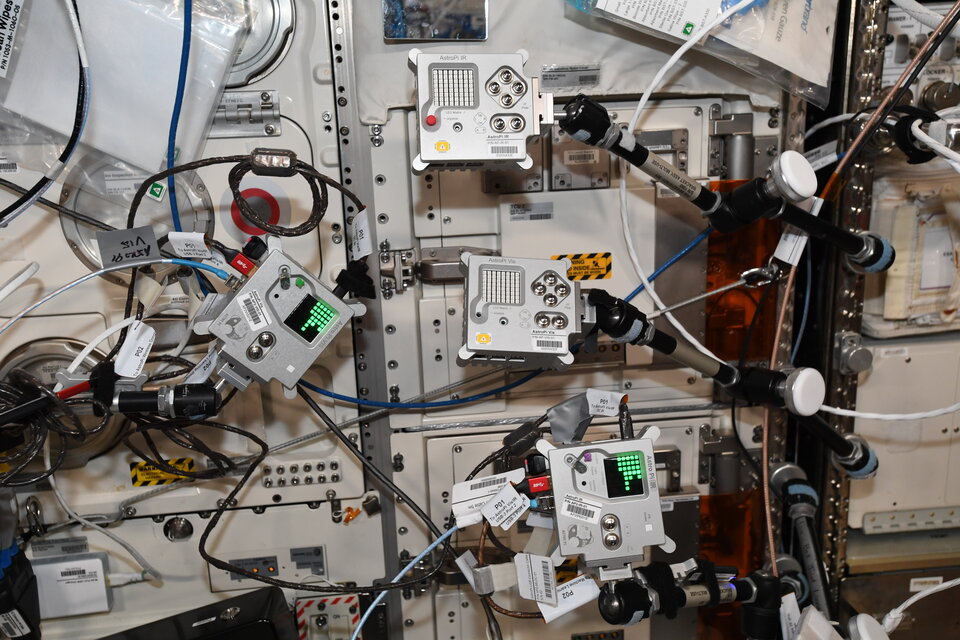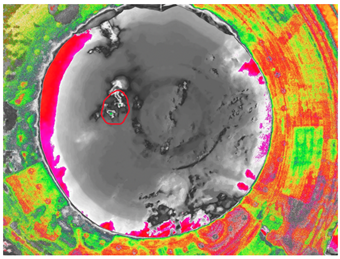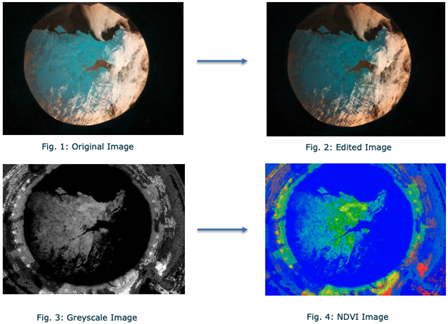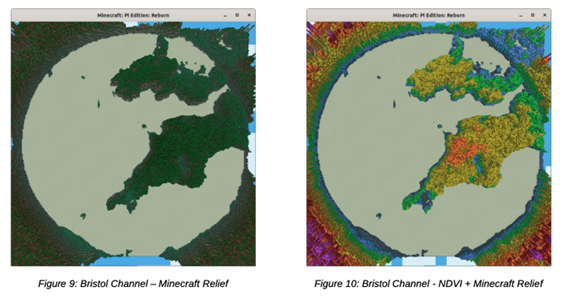Astro Pi Mission Space Lab 2021/22: The Winners!
In brief
It’s been an incredible year for the European Astro Pi Challenge. 28,126 young people from 26 countries ran 17,168 programs in space as part of either Mission Zero or Mission Space Lab. As the 2021/22 European Astro Pi Challenge draws to a close, ESA and the Raspberry Pi Foundation are delighted to announce this year’s 10 winning and 6 highly commended Mission Space Lab teams.
In-depth
What is Mission Space Lab?
799 teams of young people designed experiments and entered this year’s Mission Space Lab challenge, launched in September 2021. Their experiments could be based on one of two themes - Life on Earth or Life in Space. 502 teams were invited to Phase 2, 25% more than last year. They each received an Astro Pi kit to write and test their programs on. 299 teams submitted programs that passed rigorous testing and achieved ‘flight status'. Each of these experiments were scheduled to run for 3 hours on one of the two Astro Pi computers on the International Space Station (ISS) during May 2022.
This year’s teams were the first ever Mission Space Lab teams to run programs on the two brand-new Astro Pi units that arrived on the ISS in December 2021, which were recently named after Nikola Tesla and Marie Curie by participants in this year’s Mission Zero Challenge.

Once the programs had run, images and data from the Astro Pi’s High Quality Camera and sensors were downlinked to Earth and sent to each team for analysis. The teams submitted a final report on their experiment for judging by a panel of experts.
Clouds, Volcanos and Seaweed Rafts

The judges were hugely impressed by the range of scientific topics explored and the quality of the 205 experiment reports submitted this year. The environment and climate change was a strong theme. Several teams investigated topics such as changing water levels, wildfires and the effect of different clouds and aeroplane contrails on global warming.
Team Seekers from Itis Delpozzo Cuneo in Italy and team Adastra from St Paul's Girls' School in the UK made some great observations about reduction of water levels in the Aral Sea, located between Kazakhstan and Uzbekistan. Team Adastra compared their image of the Aral Sea with data from Google Earth, highlighting the significant decrease in water coverage since 1973. The team reflected “we have gained skills with data research and machine learning, in relation to scientific experiments, which will hopefully give us a basis to move into more complex projects with machine learning.”

Team St Marks from Saint Mark's Church of England School in the UK looked for macroplastics in the ocean, by calculating NDVI (Normalized Difference Vegetation Index) for images they had captured. This is a technique for identifying vegetation from images. The team used it to search for the rafts of sargassum seaweed that form around plastics floating on the water. They were lucky enough to successfully photograph and identify several seaweed rafts during their 3 hour experiment time.

Team Nanokids from the UK used the Coral machine learning accelerator to analyse images of clouds in real time as their experiment ran on the ISS. This could potentially be used for many purposes including warning aircraft of the risk of turbulence, predicting weather and detecting pollution. The team reported that they “ learned a lot about the various different cloud types, their characteristics and their different effects, as well as how to create a simple ML model with Teachable Machine, which will help us in future projects.”
Team Centauri from Diverbot in Spain calculated the height of clouds from images taken by the Astro Pi High Quality Camera. They were inspired by the influence of high-altitude cloud vapour on the Greenhouse Effect. They identified the potential to scale-up their experiment, to analyse hundreds or thousands of images of clouds and calculate their impact on the temperature of the Earth.
Volcanos featured in several reports. Team Six Sense from Escola Secundária Inês de Castro in Portugal ran an experiment inspired by the La Palma volcano, which erupted in September 2021, and were lucky enough to capture images of the stratovolcano Pico do Fogo in the Fogo Island, Cape Verde. Team LandISS from Liceo Scientifico “A. Landi” in Italy captured an extraordinary image of emissions from the Popocatépeti Volcano in the Iztaccíhuatl–Popocatépetl National Park in Mexico. "Popo" reactivated in 1994 and has been producing powerful explosions at irregular intervals since then.
Team Duo Do from Liceul Teoretic Tudor Vianu in Romania made a fascinating comparison of NDVI calculations for data they captured to data for the same locations prior to the Coronavirus pandemic. They wanted to see if there had been changes to vegetation health on the Earth since the pandemic. The judges were impressed with how they reported their analysis and results.

Team Atlantes from Niubit in Spain wanted to build a bridge between the real and virtual world by visualising their NDVI calculations as a three-dimensional Minecraft video game. You can see how they did this and some of their results in this video, made by the team. The judges said “Making a minecraft world out of data is simply a brilliant idea!”
From ISS ️ to Minecraft : Astro Pi Mission Space Lab 2021-22 by team Atlantes
Rocha21 from IES José Frugoni Pérez in the Canary Islands also explored different ways to communicate and share their data. They used sonoUno (software originally developed to sonify astronomical data) and online Braille translators to design tactile diagrams in order to explore their Life on Earth photographs and NDVI data, working in collaboration with six visually impaired students.
Experiments by teams working on ‘Life in Space’ included the possibility for growing fungi as space crops (Team NGC224 from CoderDojo Perugia in Italy) and the effect of temperature and pressure on the human body on earth and in space (Team CDV-CDI2 from CoderDojo Votanikos in Greece, in collaboration with CoderDojo Iraq). Team Hyperion from JVS Hyperion in Belgium investigated the effect of the sun on the Earth’s magnetic field, comparing data collected during daytime and nighttime as the ISS orbited Earth.
Team Cuza3 from Colegiul National ”Alexandru Ioan Cuza” in Romania, made "The Ballad of Pressure” by attributing notes to pressure data from the ISS. Sound and music was a feature of several entries. Team Alessi Pi from Liceo Scientifico “G.Alessi” in Italy made a melody by mapping NDVI data to a pentatonic music scale with other sensor readings mapped to additional instruments. Team Gubbins, from Hyvinkään Lukio in Finland, measured magnetic flux density to determine the strength of the Earth's magnetic field, using the Astro Pi magnetometer, which they sonified and used to make a music video.
Sonification of the earth’s magnetic field by Team Gubbins
The winning teams are….
A panel of 17 judges from ESA and Raspberry Pi Foundation took on the huge task of reviewing the 205 reports submitted against tough criteria: including scientific merit, experiment design and methodology, data analysis, report quality and innovative use of the Astro Pi hardware. This year there was also a new section asking teams to reflect on their learnings.
The ten winning teams come from schools and code clubs from France, Italy, Greece, Spain, Romania, and the United Kingdom and will each receive cool space prize.
Winning Teams
Team Project Organisation Country
AdAstra Life on Earth St Paul's Girls' School United Kingdom
Asterix Life on Earth Private household France
Atlantes Life on Earth Niubit Spain
BetFrac Life on Earth Escoles Betlem Spain
Centauri Life on Earth Diverbot Spain
DoDuo Life on Earth Liceul Teoretic Tudor Vianu Romania
DSpi Life on Earth PEKTPE Grevenon Greece
GreenPi Life in Space IESS European High School Italy
NanoKids Life on Earth Private household United Kingdom
RedsTeam Life in Space Private household Italy
In addition, six reports have been awarded as Highly Commended.
Highly Commended
Team Project Organisation Country
CDV-CDI Life on Earth CoderDojo Votanikos - Greece
CoderDojo Iraq
CorMat Life on Earth Sint-Jan Berchmanscollege Belgium
ISF Life in Space Luxembourg Tech School Luxembourg
LAZOS22 Life on Earth Aux Lazaristes La Salle France
Pithons Life on Earth The Perse School United Kingdom
Rocha21 Life on Earth IES José Frugoni Pérez Spain
You can read each of the winning and highly commended reports by clicking on the team names above. The winning and highly commended teams will be invited to an online Q&A with an ESA Astronaut in the autumn (more details soon!).
Congratulations to everyone who took part!
Every team that completed Mission Space Lab should be very proud, it is a huge achievement for them and their team leader. There were many super experiments and results, and some great data was collected. It was very hard to select the winners. They will all receive a certificate signed by ESA Astronaut Samantha Christoforetti to show family and friends that they have had a scientific experiment run on the ISS!
Everyone from the Raspberry Pi Foundation and ESA Education teams congratulates this year’s Mission Space Lab participants - we hope you found it as fun and inspiring as we did!
When will 2022/23 European Astro Pi Challenge lift off?
Mission Zero and Mission Space Lab relaunch in September 2022. Sign up for the newsletter on astro-pi.org and follow the Astro Pi Twitter account to make sure you don’t miss any announcements.


